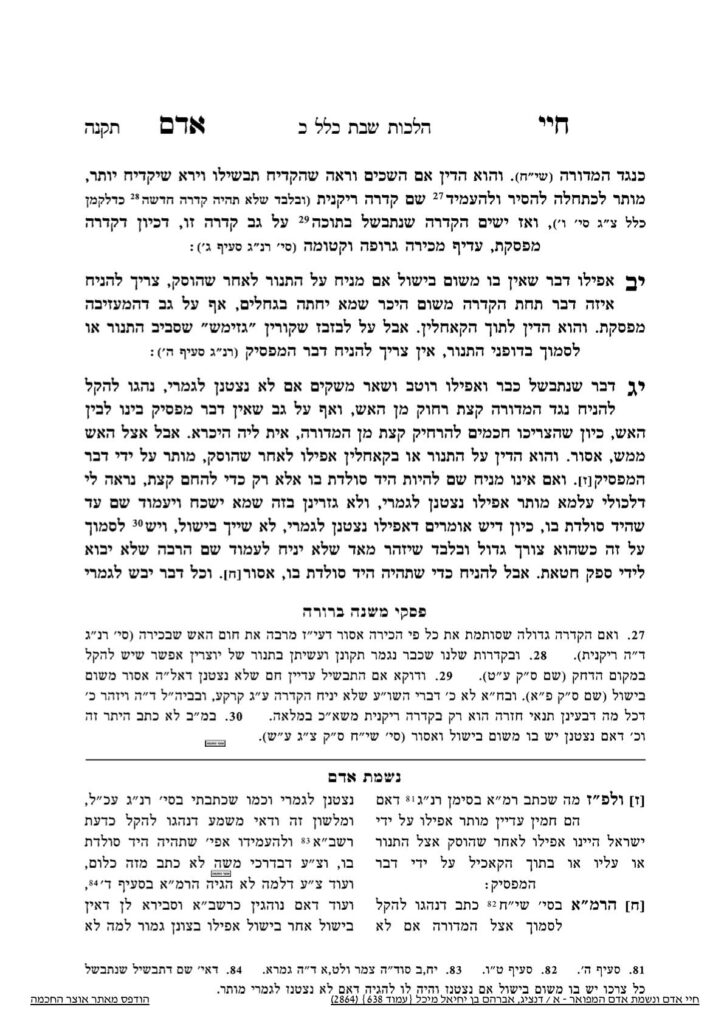We have begun siman 12, but will return to the end of siman 11 to discuss the opinion of the Chazon Ish regarding a valid blech. We learned (s541) that many poskim hold that placing a piece of metal on top of the fire serves as a hekker to remind a person not to stoke the fire, and fulfills the requirement of katum. The Chazon Ish disagrees, and holds that katum does not just serve as a hekker, but also serves to minimize the heat going to the pot. If so, according to the Chazon Ish, a blech does not work unless it minimizes the heat.
According to the Chazon Ish, there are two possible solutions to creating a valid blech. One is to create a blech which has height to it, such as by using a pot. By creating the distance between the food and the fire, one is not minimizing the fire inasmuch as minimizing the amount of heat which reaches the food, and would be a valid blech. Thus, the halacha of placing a pot over a fire does not only cover the fire but also minimize the heat.
Even according to other poskim, if one normally cooks on top of a device which covers the fire (which used to be employed to more evenly distribute heat), that device will not serve as a hekker, since it is normal to cook on it so it does not serve as a reminder. The reminder is predicated on the fact it looks strange, which will give the person pause, and in turn catches them before making a mistake.
Another solution is if a person uses a pot with food in it as his hekker, it is considered better than garuf v’katum, if such a pot is used, it is even muttar to perform nesinah lechatchillah, as we have learned.
Some suggested creating a blech with a hollow cavity that could be filled with water, known as a kedeira blech. If it approximates the pot full of food, it would be muttar to perform nesinah lechatchillah on any foods which are a davar yaveish or a davar lach which has not fully cooled. The Mishnah Berurah explained that the reason the case of a full pot is better than an empty pot is because the primary purpose of the fire is to heat the food which is in the lower pot, and the placement of the higher pot is considered incidental. If the blech is filled with water, but there is no access to the water, or the water is not meant to be used, it is no different than the case of an empty pot, where only nesinah lechatchilla is muttar.
Thus, according to most poskim, the kedeira blech is problematic. If one is able to add a spigot to the water cavity, so that the water can be used on Shabbos, it would solve this problem and allow even for nesinah lechatchillah.
Summary
According to the Chayei Adam, nesinah lechatchila (and certainly chazarah) will be muttar by placing an empty pot on top of the fire. Although we do not pasken like the Chayei Adam regarding nesinah lechatchilla, we accept the heter regarding chazarah.
This heter is the source for a blech. The empty pot functions as katum, covering the coals to create a hekker. Thus, the poskim write that placing a metal sheet on top of the fire serves the same purpose. Accordingly, the blech will allow for chazara according to the Mishnah Berurah, but not for nesinah lechatchila.
The Chazon Ish adds that part of the hekker of katum is that it minimizes the heat, so there would need to be an equivalent in a blech as well. This is accomplished by using a raised blech, or by using the heter of a pot which is full of food.
A kedeira blech is only muttar if the water can be used on Shabbos. If the water cannot be accessed, it is no different than a regular blech and it does not allow for nesinah lechatchilla.



